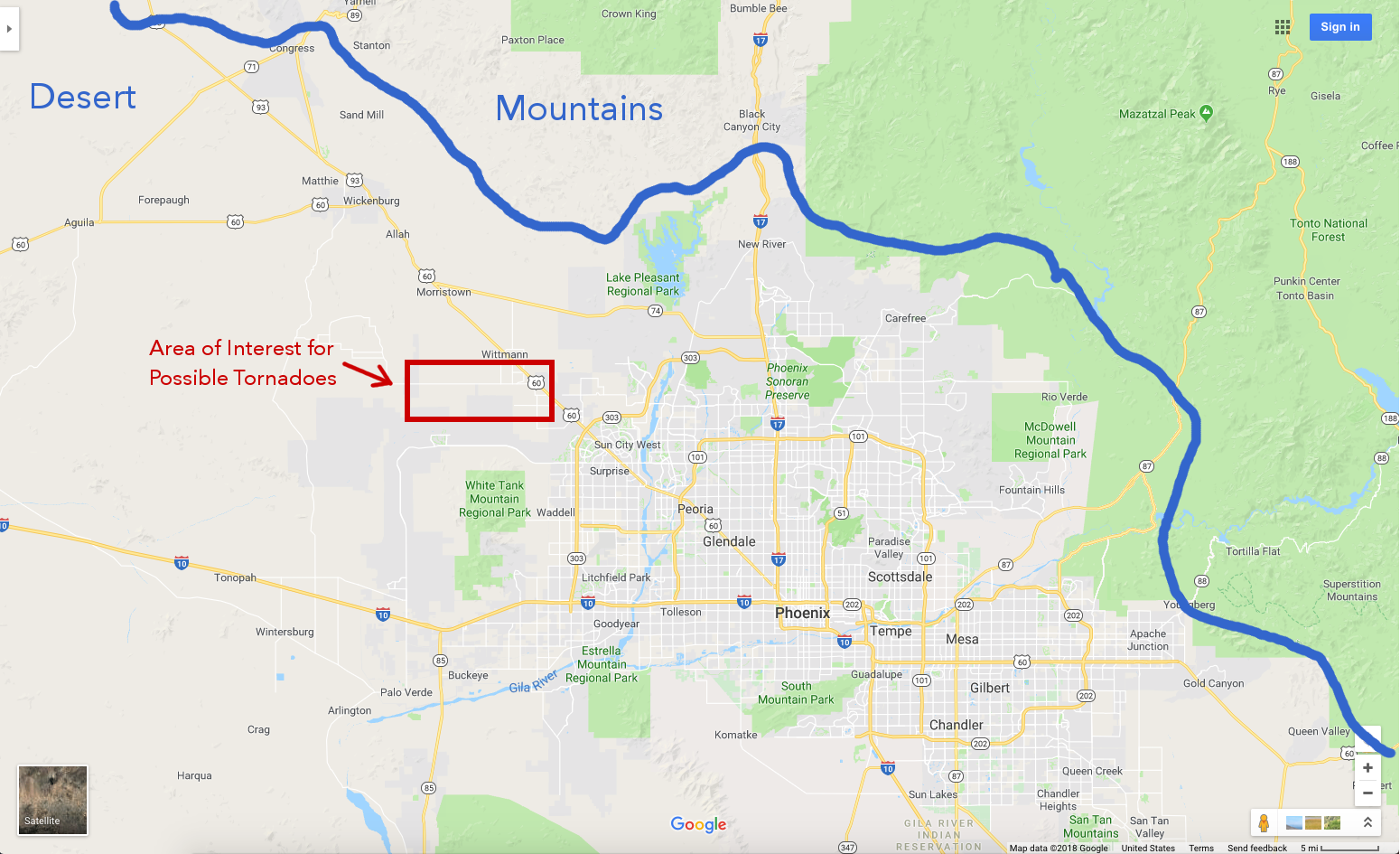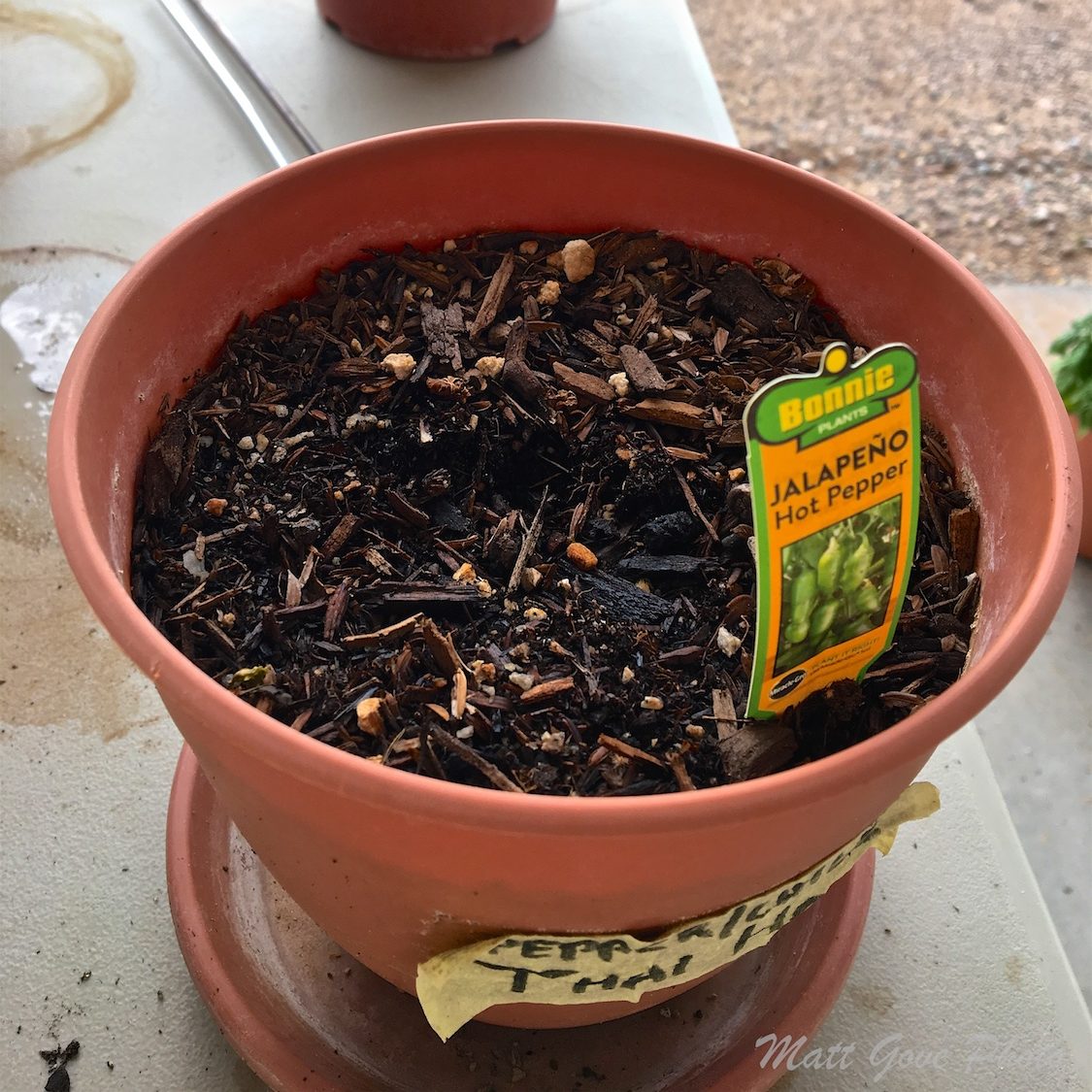The summer monsoon kicked into high gear last night as a wild night of dust storms, flash floods, and severe weather ripped through the greater Phoenix area. During the storm, I became very suspicious that a small tornado had hit my house, so after a bit of clean up this morning, I set out to see if there was any evidence of tornadoes. You should probably know that I am a trained weather spotter and also spent 3 years studying tornadoes and severe weather at the University of Oklahoma. Evidence of tornadoes – especially small tornadoes – can be very subtle, but a trained eye can find evidence that may appear “hidden” on the surface.
Before we begin, here’s a quick overview of the geography and how the monsoon storms work. The blue line is the approximate dividing line between the flat, low desert and the mountains, most of which range from about 3,000 to 7,000 feet above sea level. A very common setup in the summer is for storms to form over the mountains as air at the surface is forced up, and then the storms roll off the mountains, gaining momentum as they go downhill (just like a ball rolling downhill), and then come ripping across the desert floor. The storms last night did exactly that. In the radar loop later in this post, take notice of how the storms really start to accelerate very close to where the blue line of the map below, especially along the US-60 corridor, which runs northwest from Phoenix.

Shortly after sunset last night, the skies began to darken to our north and east as a line of severe thunderstorms rolled off the mountains. The first thing that hits with these storms is a haboob, which is a powerful dust storm that forms on the gust fronts/outflow boundaries in thunderstorms. When you’re sitting at home, dust storms are harmless, but they drop visibilities to usually less than 1/4 mile.

A haboob from a very similar storm 48 hours earlier approaches from the east
The haboob last night was even more eerie, as you could see the cloud-to-ground lightning strikes in it more and more prominently as it approached. As the sunlight faded into twilight, the winds increased further, and visibilities continued to drop. My weather station, which currently gathers its data from Lake Pleasant measured a maximum sustained wind of 60 km/h (37 mph) during the storm, but gusts at my house and throughout the area were much higher.
Now, when I say I have a suspicion that we were hit by a small tornado, you need to understand that the conditions I was working in allow it to only be just a suspicion. The video below was shot about 10-15 minutes before the suspected tornado hit. As you can see, daylight is pretty much gone, and we were in the middle of a huge dust storm. You could not see anything.
Around 8:30 PM, my first hint of a possible tornado was that the potted plants that I keep on a table on my back patio started elevating. I was able to get some of them inside before the mayhem started, but not all of them. The pots on these plants are the cheap plastic ones that don’t weigh anything and are about 6-8 inches in diameter. Perfect for becoming projectiles and missiles in this exact scenario. As I was coming back out to rescue the last few plants, I watched as the pots were sucked right off of the bottoms of at least 2 or 3 of the plants and out from underneath my covered patio before being thrown over the house and into the night.

My “garden” during more tranquil conditions
It was about right then that I was beginning to realize that standing outside like that probably wasn’t the smartest thing to do, so I retreated back into the safety of my living room. No more than about 5 seconds after I closed the door we were hit by a huge wind gust, which I estimated to be in the 120-130 km/h (75-80 mph) range. It was immediately followed by another gust of equal intensity, but in the exact opposite direction before the wind let off and returned to the direction it had been blowing. I have been scraping my brain all day, and still have yet to come up with something other than a small tornado that can explain that. By about 9:15 PM, the outflow boundary had gotten far enough out in front of the storm to cut off its fuel supply, so it began to rapidly weaken.
I got up this morning with one purpose: to try to find some evidence that had been left behind to support the theory of a tornado. A walk around the house revealed no damage to the house itself, other than a few of my covers for my external outlets were missing. When I lived in Oklahoma, looking for evidence of tornadic winds in trees and grasses was pretty straight forward. Doing it in a desert landscape like this is a whole other ballgame.

Barren Sonoran Desert landscape that would prove to be a challenge for finding evidence of a small tornado.
I wandered across the street and into the desert in the approximate path I though a possible tornado would have taken. I found a patch of grass that had been blown down in all different directions, but it’s next to impossible to say whether the storm did that or not. About 200 to 300 feet from the house I found a dead plant that I had been using as a marker in my back yard. It certainly could have been picked up by a tornado and dropped there, but it could have blown down there in straight-line winds, too. I eventually found my outlet covers, some of which were over 500 feet from the house, but the flower pots could not be recovered.

Despite all of the flower pots flying over the house, there was one instance where the plant completely vanished and the pot was left untouched.
The other telling sign of a possible tornado I found was back at the house. Inside of my grill stand, where the propane tank lives, I had wedged an empty plastic bottle way in the back corner behind the tank where there was no possible way it could just blow away in regular wind. I had noticed during the storm that the door on the grill stand got sucked open at one point, and when I looked there this morning, that plastic bottle was no where to be found.
So at the end of the day, did we have a tornado? It’s certainly possible, and maybe even likely, but I don’t have enough evidence to definitively say either “yes, we had one” or “no we didn’t”. We were hit by the end of the squall line that is most likely to produce tornadoes as it bows out, but finding evidence of small tornadoes even in the most ideal landscapes is challenging. Regardless, it’s been a wild few days, and I look forward to what the remainder of the monsoon has to offer over the next month or so.
In the next post, we will analyze some of the meteorological data from Lake Pleasant for this event. I’ll leave you with the radar loop of the entire event (watch how the storms accelerate as they come off the mountains and approach US-60 NW of Phoenix), courtesy of the National Weather Service in Phoenix.